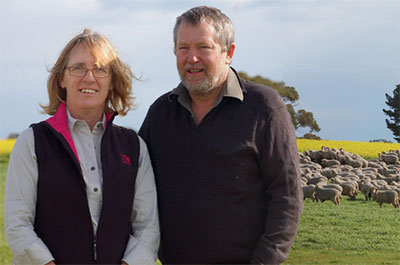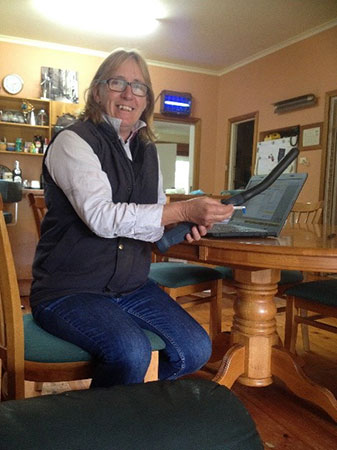Name:
Lloyd and Christine Berry
Location:
Kangaroo Island
Average Rainfall:
500 mm
Enterprises:
4,600 adult Merino’s 19.3 micron average
Farm Area:
1,200 ha (984 ha arable) 600 ha crop (beans, wheat and canola)
Lloyd and Christine Berry are second generation farmers who love to farm because they enjoy the lifestyle and challenges but they make no secret of the fact they are farming to make a profit. Their daughter Caitlin has been back on the farm for just over two years after completing an Animal Science Degree. Her love and passion is sheep breeding, genetics and animal health.
“Our daughter is a fantastic asset to our business and has fine-tuned and honed in on our breeding objectives” Christine Berry.
While Christine is as comfortable seeding the crops and handling livestock as Lloyd, both admit she is better at crunching the actual numbers. “If you don’t do your bookwork and crunch the numbers you don’t know where you’re going”’ Christine said. ”It becomes our risk management tool and helps guide decision making by enabling us to work out what our true priorities are. We are in the process of succession planning with family but it is still in early stages.
We are hopeful we can weave our way through the process and it is win-win for us and next generation”.
While many farmers may feel that bookwork isn’t ‘real’ farming and time inside is wasted time, the reverse is actually true. Good planning has enabled the Berry’s to identify the big ticket items on which they won’t compromise, for example the health of livestock and fertilisers. “These items drive our productivity and hence our profitability”, Christine explained. “Planning, both in terms of time and funds, takes the guesswork out of decision making and can stop us from making expensive mistakes. For example, we soil test so we know what fertiliser to apply and when to lime” she added.

Christine and Lloyd Berry. Photo from KI Wool Pty Ltd
Feed budgeting is another key planning tool they use. Not only does it ensure stock are kept in good condition (they aim for all stock to be in score 3 for twelve months of the year) but it helps reduce their stress levels. For example, through carefully checking of long term rainfall records for their property they have calculated that the 95 percentile for an Autumn break is 1 June —meaning that in 95 years out of 100 it’s rained by 1 June.
They work on this 95th percentile as it simply reduces the stress of worrying about something that is in their control. By ensuring they always have enough feed on hand to hand feed stock through to mid-June, the Berry’s have one less thing to worry about. The one year that doesn’t happen is okay for them. “This means that come mid-May even if it hasn’t rained we are okay. We are not forced into buying scarce and expensive grain to keep stock going”, Lloyd said
The Berry’s have considered other options for coping with variable seasons, like selling livestock or reducing the area cropped. But again by having a good handle on the farm finances they know that, for them, it’s much more cost effective to retain livestock through hand feeding than destocking and having the cost of restocking when seasons are favourable. They will manipulate the crop area, but only marginally, if they jag an ideal start and have plenty of early pasture feed (or vice versa with a very poor start).

Sheep work on the Berry property
Photo from KI Wool Pty Ltd
Technology is rapidly advancing and there is now a range of useful products available to assist with decision making. One such tool is ‘Pastures From Space’ which uses satellite imagery to show real time pasture growth. Pastures from Space data is used weekly by Christine to guide stock movement to ensure paddocks are not over grazed (i.e. which mobs need to be moved to fresh pastures and which mobs can stay in the same paddock for a while longer). “You can spend all day driving round checking paddocks to get this information, or you can do a quick scan of the whole farm while having a cuppa!“ Christine said.
Unfortunately, Pastures From space is being decommissioned later this year but the Berry’s have been pro-active and have downloaded all their historical data and saved it for future reference. The Berry’s use this historical data as a guestimate for the coming season. 2018, with very little summer rain and limited falls in March and April is starting to reflect the very dry 2002 season. Christie is able to use the pasture growth rates from 2002 to help 2018 guide decision making, whilst nothing is perfect it is really good to have some benchmarks to start with.

Christine and her grandchildren examine pastures
“We have investigating other options, like Decipher which also uses satellite imagery to monitor crop and pasture growth. We need to find a replacement for the services that Pasture from Spaces offers as it’s such a valuable tool. It enables us to know our pasture growth rates which we then match to our current stocking rates. Having completed a Prograze course we are able to ground truth the data to what we see in the paddock. We know from historical data that at the end of a season our pasture production rates can vary from 4,500kg to 11,000kg per year. A huge variation which can be capitalised on if you are aware of this”.
“Writing things down makes it happen” Lloyd Berry in describing their planning process.
“We now have a 10 year plan, 3 year plan, 12 month down to quarterly to make sure we achieve our goals. We are a lot more focused since joining Farm Owners Academy just over 2 years ago. We have learnt to be accountable to our goals and make them happen”.
With daughter Caitlin now home on the farm, they are using more EID technology. “We have used EID on all sheep since 2017, previously it was only used on stud stock. We have also purchased Tim Johnsson’s BreedElite Drafter, and use this to weigh and monitor sheep growth rates. It’s also a great tool for selling livestock as we can quickly and easily draft off a line of sheep at a specified weight” Caitlin explained.

Analysing EID data
Another new online tool is Safe Ag Systems. “It’s a great app for tracking all the OH&S requirements from SOP’s to staff inductions. Its very user friendly, compatible with all our phones and ensures the responsibility stays with employer and employee”
They encourage others to seek sound independent financial advice and not to be afraid of paying tax as they say ‘it means you’re making money!’
It was probably being involved in a Property Management Planning course back in the early 1990s that was the catalyst for them realising that proper planning was the key to success. Time in the office and time spent thinking about where they wanted to be really set their ground rules.
It gave them the tools to work through the big ticket items like land purchase, down to the smaller details like changes to the cropping program depending on the timing of the break.
The Berry’s summarised their current position in the following way:
“We are now comfortable with what we have achieved in terms of farm build up and increasing productivity. Our planning now focuses on ensuring we are a viable business moving onto the next generation. Producing the maximum quantity & quality of specified food & fibre from our land without degradation”.
Prepared by Lyn Dohle, Primary Industries and Regions SA: Rural Solutions SA (2018). Adapted from case study written by Lyn Dohle funded by the Kangaroo Island Natural Resources Management Board.
This project is supported by AWI, Primary Industries and Regions SA and SA Sheep Industry Fund.